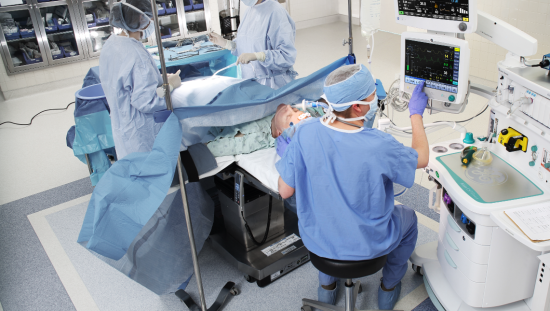Introduction
Patient care remains the top priority for anesthesia providers, who are deeply focused on clinical excellence. At the same time, surgical teams face a growing responsibility to adopt environmentally sustainable practices. The challenge lies in balancing uncompromised care with sustainability—especially as in-patient surgery volumes are projected to rise by 13%. [1] The increase in procedures come amid a workforce shortage of anesthesia providers. [2]
Addressing these pressures requires more than clinical expertise alone. It calls for technologies that simplify complex processes, integrate seamlessly into workflows, and reduce the cognitive and operational burden on care teams. By making the implementation of strategies such as low-flow anesthesia* and lung protective ventilation more efficient, these innovations may help clinicians deliver quality care while potentially easing the strain of a constrained workforce. They may also support goals such as reducing waste and healthcare-related costs, while promoting patient care-excellence.
This article is the first in a three-part series exploring how innovation may support anesthesia teams in meeting today’s clinical, operational, and sustainability challenges. Part 1 focuses on low-flow anesthesia and its potential to reduce anesthetic agent consumption and environmental impact. Part 2 will examine lung protective ventilation strategies, and Part 3 will highlight the role of continuous monitoring from intraoperative care through postoperative recovery.
Why now is the time for low flow anesthesia
Operating rooms account for about 70% of a hospital’s waste and produce three to six times more carbon emissions than the average across the rest of the health system. [3] Therefore, anesthesia teams play a pivotal role in reducing the environmental impact of surgical care. Anesthetic gases alone account for more than half (51%) of the direct greenhouse gas emissions from a typical surgical procedure, [4] making anesthesia professionals uniquely positioned to lead sustainability efforts in the OR.
To reduce greenhouse gas emissions in the OR, a growing number of hospitals and anesthesia teams are implementing low flow anesthesia practices and protocols.[5,6,7] For purposes of this series, we define low-flow anesthesia as reducing gas flow to the lowest level consistent with equipment capabilities and safe and effective patient care (often resulting in mean fresh gas flow rates below 1 liter per minute).[8]
Low-flow anesthesia is “a promising approach to anesthesiology practice overall,” particularly as it relates to patient safety, cost-effectiveness, and environmental sustainability factors.[9]
- Patient safety: LFA has been shown to improve the dynamics of how patients breathe during anesthesia, decrease fluid loss, reduce the amount of inhalational anesthetics needed,[10] and reduce loss of heat and humidity from the lungs.[11] Demonstrating the patient safety benefits of LFA, the University of Michigan’s Green Anesthesia Initiative resulted in “modernizing care and improving safety for patients.”[5] Further, the university achieved its reduction without a change in “therapeutic anesthetic delivery, pain scores, postoperative nausea and vomiting in the recovery room, or intraoperative awareness with explicit recall.”[12]
- Cost effectiveness: Research surveying more than 200 anesthesia providers shows that 83% say adopting low flow anesthesia would reduce costs.[13] In fact, an evidence-based simulation of cost-savings across all anesthetic agents projected a 48% reduction in costs of volatile anesthetics using low flow anesthesia.[14] Another study simulating the estimated cost-savings for a large academic medical center is $95,536 per year, which results primarily from reducing anesthetic gas usage.[15]
- Environmental impact: The survey of anesthesia providers finds that 74% believe low flow anesthesia would benefit their organization’s environmental sustainability efforts.[13] One comparative study also shows a potential 44% decline in the rate of greenhouse emissions when employing low flow with automated software.[16] Illustrating the impact of low flow anesthesia, Keck Medicine of the University of Southern California reduced anesthesia-related waste by 73% during a trial run of the GE HealthCare End-tidal Control* software in September 2023.[7]
Low flow as a standard of care and a professional obligation
Research shows that more than 90% of anesthesiologists and CRNAs believe low-flow anesthesia will become a standard of care within the next decade.[13] A range of experts are already calling on anesthesia providers to implement low flow anesthesia as a “professional obligation to the present and future generations on planet Earth.”[17]
Automation technology as a catalyst for low flow anesthesia
The American Society of Anesthesiologists recommends that anesthesia providers use “emerging technologies and AI to aid decision-making and deliver care more efficiently, such as increased use of automation.”[2] Automating low flow anesthesia can further reduce anesthetic waste, greenhouse gas emissions, and agent costs.[13]
Automating the delivery of low flow anesthesia based on clinician set targets, such as with GE HealthCare’s End-tidal Control** software on Aisys™ CS2, may help reduce anesthetic gas consumption and greenhouse gas emissions [11] Automation can also drive cost savings on anesthetic agents and bring clinical benefits by reducing manual repetitive tasks so anesthesia providers can focus on delivering a more stable, accurate, and precise anesthetic at lower flows than manual administration.[11]
Sources:
[1] 2024 Impact of change forecast highlights, Sg2 Health Care Intelligence
https://vizientinc-delivery.sitecorecontenthub.cloud/api/public/content/47212a11b76244d2b3bc7f0e0db086e5
[2] Anesthesia workforce shortage poses threat to healthcare, American Society of Anesthesiologists https://www.asahq.org/about-asa/newsroom/news-releases/2024/06/anesthesia-workforce-shortage-poses-threat-to-health-care
[3] Operating rooms are the climate change contributor no one is talking about, American Association for the Advancement of Science
https://www.eurekalert.org/news-releases/951971
[4] Asfaw SH, Galway U, Hata T, Moyle J, Gordon IO. Surgery, anesthesia, and pathology: A practical primer on greening the delivery of surgical care. J Clim Change Health. 2021;4:100076. doi:10.1016/j.joclim.2021.100076.
[5] Use of greener anesthesia protects patients and the environment Michigan Medicine’s Health Lab, University of Michigan
https://www.michiganmedicine.org/health-lab/use-greener-anesthesia-protects-patients-and-environment
[6] Earth Day: How anesthesiologists are tackling greenhouse gases in the operating room, UC Davis Health
[7] Keck Medicine is ‘Greening the OR,’ HSC News
https://hscnews.usc.edu/keck-medicine-is-greening-the-or-2
[8] Low flow anesthesia: two key developments that could help increase utilization among anesthesiologists and CRNAs, Clinical View, GE HealthCare
https://clinicalview.gehealthcare.com/blog/low-flow-anesthesia-two-key-developments-could-help-increase-utilization-among
[9] Anesthesia and its environmental impact: approaches to minimize exposure to anesthetic gases and reduce waste, Medical Gas Research https://journals.lww.com/mgar/fulltext/2025/03000/anesthesia_and_its_environmental_impact_.10.aspx
[10] Inhalational anaesthesia with low fresh gas flow, Indian Journal of Anaesthesia https://journals.lww.com/ijaweb/fulltext/2013/57040/inhalational_anaesthesia_with_low_fresh_gas_flow.5.aspx
[11] Patient safety and low flow anesthesia, Anesthesia Patient Safety Foundation
https://www.apsf.org/article/patient-safety-and-low-flow-anesthesia/
[12] Environmental and patient safety outcomes of a health system Green Anesthesia Initiative (GAIA): a retrospective observational cohort study, The Lancet Planetary Health
https://www.thelancet.com/journals/lanplh/article/PIIS2542-5196%2824%2900331-0/fulltext
[13] Low flow anesthesia: more than 200 anesthesiologist and CRNAs weigh in on benefits, challenges, and opportunities, GE HealthCare
https://clinicalview.gehealthcare.com/market-report/low-flow-anesthesia-more-200-anesthesiologists-and-crnas-weigh-benefits-challenges
[14] Evidence-based project: cost savings and reduction in environmental release with low flow anesthesia, AANA Journal, American Association of Nurse Anesthesiology
http://www.onlinedigeditions.com/publication/?i=691174&article_id=3865755&view=articleBrowser
[15] Environmental and economic impacts of end-tidal control of volatile anesthetics: a scoping review and analysis, The Open Anesthesia Journal
https://openanesthesiajournal.com/VOLUME/19/ELOCATOR/e25896458355905/
[16] Financial and environmental costs of manual versus automated control of end-tidal gas concentrations, Anaesthesia and Intensive Care
https://journals.sagepub.com/doi/10.1177/0310057X1304100116
[17] Low flow anaesthesia – underused mode towards “sustainable anaesthesia” Indian Journal of Anaesthesia
https://journals.lww.com/ijaweb/fulltext/2018/62030/low_flow_anaesthesia___underused_mode_towards.3.aspx
*End-tidal Control in the United States is indicated for patients 18 years of age and older
Refer to the anesthetic agent labeling for information regarding indications for use, warnings, and other relevant clinical information specific to that anesthetic agent. Any decisions regarding selection of anesthetic agent and flow rate should be made at the discretion of the clinician and in their medical judgment based on available information.
Nothing in this material should be used to diagnose or treat any disease or condition. Readers must consult a healthcare professional.
GE is a trademark of General Electric Company used under trademark license. Aisys and Carestation are trademarks of GE HealthCare.
JB34668XX








